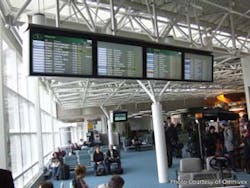As advancing technology continues to enhance the many operational aspects of the airport terminal, upgrades in digital signage remain an important investment for airports. Now considered by many in the display industry to be better described as ‘visual communications systems,’ airport information signage is now capable of capturing revenue, being incorporated into attractive architectural elements, and most importantly serving as effective customer service and communication tools. Says Omnivex president Jeff Collard, “Today, a digital communication system is a live real-time information system that takes data from different places, manipulating that data by providing it in a useful visual sense.”
Comments NEC director of business development Mike Zmuda, “The term digital signage has a fairly broad connotation today.” Collard agrees, stating, “[Digital signage] is really a visual communications system; it’s how you take information and present it visually to help people make a decision.”
As airports update their technological infrastructure, some are using a holistic approach by installing comprehensive digital signage platforms that incorporate intelligent, intuitive hardware with software that provides creative content and advertising revenue possibilities, relates Collard.
Also in this article, Zmuda describes NEC’s Vukunet platform which enables advertisers and networks to work together to generate revenue; Collard explains how larger airports can leverage their technology and remotely manage visual communication campaigns for smaller airports; and Planar product marketing manager John Dixon describes Huntsville International Airport’s Clarity Matrix LCD Video Wall System.
CONTEXTUAL COMMUNICATION
“We have a lot of airports that are coming to a point where their systems are going to need to be replaced,” says Collard. “A lot of airports are looking at updating their infrastructure, and as part of that they’re really at the crossroads of build or buy in terms of managing all of that technology.”
Operating systems are changing with new upgrades, he says; and graphics capabilities are substantially better than a few years ago. “The challenge is that nothing in the airport industry really happens that fast.
“Airports have budgets that have to be appropriated, and there’s a lot of planning that has to go into these things. I think what you’re going to see in the next five years is a lot of airports going to an established digital signage platform, and basically building their needs upon that, rather than trying to build their own systems.”
Omnivex is a big proponent of contextual communication, remarks Collard. An example of this is the company’s Moxie platform, which among other things looks at flight information and automatically displays content in the language most relevant to a particular flight’s passengers.
“The systems are smart enough now to recognize and integrate the flight information display system (FIDS) data into the content displayed on the screen; the system renders the content to the desired effect in real-time based on external conditions,” explains Collard.
The idea of having of having intelligent content as opposed to everything being ‘pre-canned,’ he says, eliminates work on the back-end because the airport doesn’t have to plan; the system does everything intuitively once specific rules are defined (tagging metadata to content and defining the information, then giving a series of conditions that tell the system what to display in real-time).
“The concept of smart content is relatively new because typically what the airports were doing was pre-canning content, and information was based on the lowest common denominator as opposed to information most pertinent to the people who are in front of the screen,” remarks Collard.
“One of the fascinating things about airports is, a lot of them are moving away from putting everything on every screen and flooding people with information; instead they’re giving them only the information that the need to help move them to the next screen.”
COMPREHENSIVE COMMUNICATION
In a holistic fashion, visual communication is coming under one umbrella as a single comprehensive digital signage platform that houses different pieces of data, says Collard. “All you’re doing is recoordinating where the sources of data are, and changing the rules as to how it builds and renders the content in real-time.
“You’re getting end-to-end solutions rather than multiple functions to support, which is more economical to manage for an airport.”
With regard to airport size, Collard says the company seems to be spending more time with larger airports, and seeing more larger airports taking over and managing visual communication systems for smaller airports.
“YVR [Vancouver International Airport] does most of the interior British Columbia airports; smaller airports like Prince George and Hamilton Airport near Toronto,” relates Collard. “The servers are all running in Vancouver — it has the infrastructure; it has the people; it has the technology; it has the flight information. It is actually providing the service for smaller airports.
“That’s a big trend right now because once the infrastructure is put in, as YVR has done, an airport can manage, monitor, and operate the system remotely at a lower cost system-wide.
“Leveraging the technology and providing the service to smaller airports is easy for [YVR] to do; and the smaller airports are getting a robust industrial-strength system at a fraction of the cost.
VUKUNET
“We put together a platform that enables advertisers and networks to be able to work together,” says NEC’s Zmuda. The platform is called Vukunet, and it’s a universal ad platform that connects digital out-of-home networks with ad agencies.
The software will run ads on designated screens, doing so without the difficulty that often comes with integrating software together, he adds. “We created a patent-pending technology that kind of lets everything run independently, and what the network owner does is identify the demographics for a particular screen and designate an amount of ad time for it,” explains Zmuda.
“The ad inventory is automatically seen by advertisers that sign up on the platform; and they can go ahead and make an offer to the airport for specific ad time. The system then automatically sends the advertiser’s software to a media player at the airport.
“All the airport has to do is approve the price and the content — the placement doesn’t require an IT specialist to add the content to a playlist … all of that happens automatically in a streamlined fashion.
“At the end of the day, the system uploads back to our servers to inform us an ad was run; we get the verification, bill the ad agency, and pay the network.”
The company is in launching mode currently, relates Zmuda. He says NEC has well over 500 general networks signed up for Vukunet, including a couple airports.
VIDEO WALL SYSTEMS
Planar, a provider of display solutions for the airport industry for more than ten years, offers a seamless video wall solution, the Clarity Matrix LCD Video Wall System, that is becoming prevalent particularly in the airport market, says product manager Dixon.
“What you’ve seen over the past ten years is direct-view LCDs (liquid crystal display) in larger formats becoming very popular for displays being used in airports,” remarks Dixon.
“Panels have become larger and resolutions have increased; the trend that we’ve seen over the past two years is LCDs with narrower bezels [a border around a screen].
“The focus has been, how do we get that frame as small as possible so that an array [of displays] can be tiled in an acceptable and attractive fashion.” In the last year, he adds, LCDs have evolved to have bezels that are smaller than a half inch; the small bezel lends itself for tiling (stacking displays next to and on top of one another).
“With new LCD technology, you get 7.3 mm of total bezel between two panels — we designed this product to be a tileable solution.”
It’s important, says Dixon, to think of the product as a system, not a single monitor or display. A key elements is the integrated mounting system (Easy-Access Mounting System), a custom mounting system provided by Planar that allows for perfect panel to panel alignment, a shallow depth of 4.5 inches, and the capability to put the displays into service mode so an individual display can be accessed without adjusting the display units around it.
Another key feature: traditionally a power supply is located on the back of an LCD monitor along with electronics that accepts the signal from the video source that is driving the display; “We’ve removed those components so they can be put in a convenient remote location,” explains Dixon.
Having the internal components of the displays located away from the array itself offers specific benefits for airports, he says. It allows for an ultra-thin display depth; fans, which are required to cool the components, are also put in a remote location reducing the noise of the monitors; and common points of failure (usually related to the internal components) are also moved away from the LCDs allowing for easier servicing of the system. The benefits ultimately lower the system’s total cost of ownership, says Dixon.
At Huntsville, the video wall system is three displays high by seven wide (21 units total). The units are 46 inch-LCD video displays; content is segmented so that a two by three section of screens on the left side of the array are dedicated for departure information, a three-by-three screen section in the middle of the wall runs advertising and local television, and a two-by-three screen segment on the right displays arrival information.
The system is a single concave array that also utilizes electronics that allow the airport to stretch an image across multiple displays. One of the primary benefits Huntsville saw in the design, says Dixon, was the ability to remote locate each of the display’s internal components; all components are located some 100 feet from the array.
About the Author

